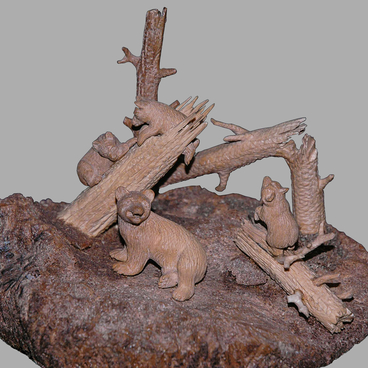The harp is a seven-stringed musical plucked instrument of ancient origin, the simplest types of which were known in Ancient Egypt and Babylon. In the North of Western Siberia, it was widespread among the Selkups, Ob Ugrians, Mansi, and Khanty. Researchers suggest that the simplest harps, which include the Tobolsk specimen, originate from hunting and combat bows. The invention of a plucked musical instrument could have been prompted by the sound of a bowstring vibrating after a shot.
The corner harp entered the museum’s funds in 1905 from a resident of Surgut N.V. Yevseyev. The master cut out the body of the instrument from a single piece of wood and gave it the shape of a floating bird with the head of a horse, i.e. a trapezoidal muzzle with small rectangular appendix ears. Flattened trapeze-platform neck smoothly turns into a hollow trunk body. On instruments of this type, the neck most often ended with a carved bird’s head, and the horse was extremely rare.
Among the Mansi peoples, the harp is called toorsapt-yuh literally translated from the Mansi language as ‘tree with a crane’s neck’, or “crane”s neck made of wood”. The Northern Khanty people call this instrument tor-saplyukh. It is very similar to its Mansi counterpart. The main secret of harp makers is how to choose the right tree. These secrets have been passed down from generation to generation. Usually, the musicality of a tree, mostly cedar or pine, was determined in winter with a wooden hammer. Then a suitable tree was cut down, floated down the river in spring or summer, dried, and then made into a harp.
They played this harp with two hands. They played the melody with the left, and plucked one of the lower strings with the right, thus having made monotonous low sounds that gave the music solemnity. The strings of the instrument were stretched using pegs in the form of spatulas located on the neck. According to ethnographic literature, from 5 to 13 strings of copper, bronze, or animal veins could be stretched between the pegs and the soundboard. The Tobolsk exhibit has no strings or crossbars.
The timbre-sound capabilities of the harp allowed it to be used in combination with other musical instruments. The harp was often used for bear festivals. They are now almost not played. You can only imagine and recreate the musical culture of the Khanty people with the help of preserved copies.
The corner harp entered the museum’s funds in 1905 from a resident of Surgut N.V. Yevseyev. The master cut out the body of the instrument from a single piece of wood and gave it the shape of a floating bird with the head of a horse, i.e. a trapezoidal muzzle with small rectangular appendix ears. Flattened trapeze-platform neck smoothly turns into a hollow trunk body. On instruments of this type, the neck most often ended with a carved bird’s head, and the horse was extremely rare.
Among the Mansi peoples, the harp is called toorsapt-yuh literally translated from the Mansi language as ‘tree with a crane’s neck’, or “crane”s neck made of wood”. The Northern Khanty people call this instrument tor-saplyukh. It is very similar to its Mansi counterpart. The main secret of harp makers is how to choose the right tree. These secrets have been passed down from generation to generation. Usually, the musicality of a tree, mostly cedar or pine, was determined in winter with a wooden hammer. Then a suitable tree was cut down, floated down the river in spring or summer, dried, and then made into a harp.
They played this harp with two hands. They played the melody with the left, and plucked one of the lower strings with the right, thus having made monotonous low sounds that gave the music solemnity. The strings of the instrument were stretched using pegs in the form of spatulas located on the neck. According to ethnographic literature, from 5 to 13 strings of copper, bronze, or animal veins could be stretched between the pegs and the soundboard. The Tobolsk exhibit has no strings or crossbars.
The timbre-sound capabilities of the harp allowed it to be used in combination with other musical instruments. The harp was often used for bear festivals. They are now almost not played. You can only imagine and recreate the musical culture of the Khanty people with the help of preserved copies.
